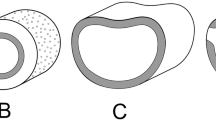Abstract
The present paper deals with the epidermal structure and ontogeny of stomata in vegetative and floral organs ofHybanthus enneaspermus. The epidermal cells are either polygonal or elongated with straight, sinuous or arched thick anticlinal walls. The surface of the cuticle shows parallel striations radiating from the guard cells or hair bases. Unicellular and uniseriate bicellular trichomes with verrucose margins have been observed on all organs. The mature stomata are anisocytic, paracytic, anomocytic and transitional between anisocytic and paracytic. The ontogeny of anisocytic and paracytic stomata is syndetocheilic or mesogenous, anomocytic is haplocheilic or perigenous, while that of the transitional type is mesoperigenous. Four types of stomata have been observed on all the vegetative and floral organs and their ontogeny from organ to organ of this plant is constant. Stoma with a single guard cell is the result of disintegration of one of the guard cells before or after pore formation. Contiguous stomata are also occasionally noticed.
Abstract
Předložená práce se zábýva strukturou epidermis a ontogenezí průduchů u vegetativních a květních orgánůHybanthus enneaspermus. Epidermální buňky jsou mnohoúhelníkové nebo protáhlé s rovnými, klikatými nebo obloukovitými, tlustými antiklinálními stěnami. Povrch kutikuly má paralelní rýhování paprskovitě se rozbíhající od svěracích buněk nebo bází trichomů. Jednobuněčné a jednořadě dvoubuněčné trichomy s bradavičnatými okraji jsou na všech orgánech. Dospělé průduchy jsou anisocytické, paracytické, anomocytické a na přechodu, mezi typem anisocytickým a paracytickým. Ontogeneze anisocytických a paracytických průduchů je syndetocheilická nebo mesogenní, anomocytických je haplocheilická nebo perigenní, zatím co u přechodného typu je mesoperigenní. Na všech vegetativních i květních orgánech byly pozorovány tyto ětyři typy průduchů; jejich ontogeneze je od orgánu k orgánu konstantní. Průduch s jednou svěrací buňkou je výsledkem rozložení jedné ze svěracích buněk před nebo po vytvoření póru. Dosti často se vyskytují průduchy těsně k sobě přiléhající.
Abstract
Работа касается структуры эпидермис и онтогенеза устьиц вегетативных органов и оргапов цветка уHybanthus enneaspermus. Эпидермальные клетки являются многоугольниками или протянутые, с прямыми, изогнутыми или зигзагообразными, толстыми антиклинальными стенками. На поверхности кутикулы имеются бороздки радиально расходящиеся от замыкающих клеток устьиц или от оснований волосков. Одноклеточные и однорядные двухклеточные трихомы с бородавчатыми краями находятся на всех органах. Взрослые устьица принадлежат к типу анизоцитическому, парацитическому, аномоцитическому и переходному между анизоцитическим и парацитическим. Онтогенез анизоцитических и парацитических устьиц синдетохеилический или мезогенный, аномоцитических уетьих,—ганлохеилический или неригенный, в то время как у переходного тина—мезоперигенный. На вцех вегетативных и генеративных органах находятся устьица этих четырех типов, их онтогенез одннаков при переходе от органа к органу. Устьице с одной замыкающей клеткой образуются в результате разложения одной из замыкающих клеток до или после образования поры. Довольно часто обнаруживаются уетьица непосредетвенно прилегающие друг к другу.
Similar content being viewed by others
References
Ahmad, K. J.: Cuticular striations.—Curr. Sci.31: 388–390, 1962.
Ahmad, K. J.: On stomatal abnormalities inSolanaceae.—Sci. and Cult.30: 349–351, 1964.
Original paper not seen.Florin, R.: Untersuchungen zur stammesgeschichte derConiferales undCordaitales. I Morphologie und Epidermisstruktur der Assimilationsorgane bei rezenteen Koniferen.—Svenska Vetenskaakad. Handl.10: 1–588, 1931.
Original paper not seen.Florin, R.: Studien über dieCycadales des Mesozoikums nebst Erorterungen über die Spaltoffnungsapparate derBennettitales K.—Svenska Vetenska akad. Handl.12: 1–134, 1933.
Gupta, S. C., Palival, G. S., Gupta, M.: The development of stomata in vegetative and reproductive organs ofBupleurum tenue Buch.-Ham ex D. Don.—Ann. Bot.29: 645–654, 1965.
Inamdar, J. A.: Stomatal ontogeny inJasminum officinale L.—Curr. Sci.36: 443–444, 1967.
Inamdar, J. A.: Ontogeny of stomata in someOleaceae.—Proc. Ind. Acad. Sci.67 (4): 157–164, 1968a.
Inamdar, J. A.: Development of stomata in vegetative and fioral organs of someCaryophyllaceae. Austr. J. Bot.16 (3): 445–449, 1968b.
Inamdar, J. A.: Epidermal structure and ontogeny of stomata in someVerbenaceae.—Ann. Bot.33: 55–66, 1969a.
Inamdar, J. A., Gopal, B. V., Chohan, A. J.: Development of normal and abnormal stomata in someAraliaceae.—Ann. Bot.33: 67–74, 1969b.
Paliwal, G. S.: The development of stomata inBasella rubra Linn.—Phytomorphology15: 50–53, 1965.
Paliwal, G. S.: Ontogeny of stomata in someCruciferae.—Can. J. Bot.45: 495–500, 1967.
Paliwal, G. S., Bhandari, N. N.: Stomatal development in someMagnoliaceae.—Phytomorphology12: 409–412, 1962.
Pant, D. D.: On the ontogeny of stomata and other homologous structures.—Pl. Sci. Ser. Allahabad.1: 1–24, 1965.
Pant, D. D., Banerji, R.: Epidermal structure and development of stomata in someConvolvulaceae. —Senck. biol.46: 155–173, 1965.
Pant, D. D., Kidwai, P.: On the diversity in the development and organisation of stomata inPhyla nodiflora (L.)Green.—Curr. Sci.33: 653–654, 1964.
Pant, D. D., Kidwai, P.: Development of stomata in someCruciferae.—Ann. Bot.31: 513–527, 1967.
Pant, D. D., Mehra, B.: Ontogeny of stomata in someRanunculaceae.—Flora155: 179–188, 1964.
Pant, D. D., Verma, B. K.: Development of stomata in the leaves ofNotonia grandiflora DC. J. Ind. bot. Soc.42: 384–391, 1963.
Sen, S.: Stomatal types inCentrospermae.—Curr. Sci27: 65–67, 1958.
Shanks, R.: Differentiation in the leaf epidermis.—Austr. J. Bot.13: 143–151, 1965.
Stebbins, G. L., Khush, G. S.: Variation in the organisation of stomatal complex of monocotyledons and its bearing on their phylogeny.—Am. J. Bot.48: 51–59, 1961.
Original paper not seen.Strasburger, E.: Ein Beitrag zur Entwicklungsgeschichte der Spaltoffnungen.—H. Wiss. Bot.5: 297–342, 1866-1867.
Original paper not seen.Tognini, F.: Contribuzione allo studio della organogenia comparata degli stomi.—Atti. Ist. bot. Univ. Lab. Crittogam. Pavia.4: 1–42, 1987.
Yarbrough, J. A.: History of the leaf development inBryophyllum calycinum.—Am. J. Bot.22: 467–481, 1934.
Author information
Authors and Affiliations
Additional information
Address: Vallabh Vidyanagar, Gujarat, India.
Rights and permissions
About this article
Cite this article
Inamdar, J.A. Epidermal structure and development of stomata in vegetative and floral organs ofHybanthus enneaspermus (Linn.)F. Muell . Biol Plant 11, 248–255 (1969). https://doi.org/10.1007/BF02920804
Received:
Issue Date:
DOI: https://doi.org/10.1007/BF02920804




